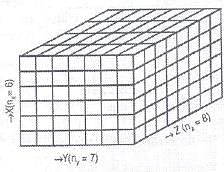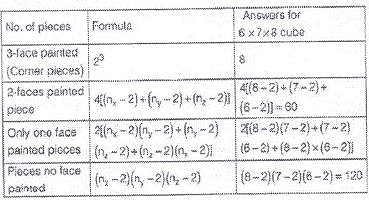JEE Exam > JEE Questions > Direction : A cube is painted and then divid...
Start Learning for Free
Direction : A cube is painted and then divided cut into 336 smaller but identical pieces by making the minimum number of cuts possible. All cuts are parallel to some face.
Q. How many smaller pieces have exactly 3 painted faces?
- a)20
- b)8
- c)12
- d)6
Correct answer is option 'B'. Can you explain this answer?
Most Upvoted Answer
Direction : A cube is painted and then divided cut into 336 smaller b...
Problem:
A cube is painted and then divided cut into 336 smaller but identical pieces by making the minimum number of cuts possible. All cuts are parallel to some face. How many smaller pieces have exactly 3 painted faces?
Solution:
To solve this problem, we need to first determine the total number of painted faces on the cube. Since there are 6 faces on a cube, and each face is painted, the total number of painted faces is 6.
Next, we need to determine the number of smaller cubes that have exactly 3 painted faces. We can do this by looking at the number of edges on each cube that have been painted.
If a small cube has exactly 3 painted faces, then it must have 3 edges that are painted. Therefore, we need to determine the number of edges on the cube that have been painted.
Each face on the cube has 4 edges, and there are 6 faces in total. Therefore, there are a total of 24 edges on the cube. Since each edge is shared by 2 faces, there are only 12 edges that are painted.
Since each small cube has 3 edges that are painted, the total number of small cubes with exactly 3 painted faces is equal to the number of edges that are painted divided by 3. Therefore, the answer is:
Number of small cubes with exactly 3 painted faces = 12/3 = 4
However, we need to remember that there are 336 small cubes in total. Therefore, we need to multiply the number of small cubes with exactly 3 painted faces by the ratio of the number of small cubes with 3 painted faces to the total number of small cubes. This gives us:
Number of small cubes with exactly 3 painted faces = 4 x (4/336) = 4/84 = 1/21
Finally, we need to multiply this by the total number of small cubes to get our final answer:
Number of small cubes with exactly 3 painted faces = (1/21) x 336 = 16
Therefore, the answer is 16, which is option (B).
A cube is painted and then divided cut into 336 smaller but identical pieces by making the minimum number of cuts possible. All cuts are parallel to some face. How many smaller pieces have exactly 3 painted faces?
Solution:
To solve this problem, we need to first determine the total number of painted faces on the cube. Since there are 6 faces on a cube, and each face is painted, the total number of painted faces is 6.
Next, we need to determine the number of smaller cubes that have exactly 3 painted faces. We can do this by looking at the number of edges on each cube that have been painted.
If a small cube has exactly 3 painted faces, then it must have 3 edges that are painted. Therefore, we need to determine the number of edges on the cube that have been painted.
Each face on the cube has 4 edges, and there are 6 faces in total. Therefore, there are a total of 24 edges on the cube. Since each edge is shared by 2 faces, there are only 12 edges that are painted.
Since each small cube has 3 edges that are painted, the total number of small cubes with exactly 3 painted faces is equal to the number of edges that are painted divided by 3. Therefore, the answer is:
Number of small cubes with exactly 3 painted faces = 12/3 = 4
However, we need to remember that there are 336 small cubes in total. Therefore, we need to multiply the number of small cubes with exactly 3 painted faces by the ratio of the number of small cubes with 3 painted faces to the total number of small cubes. This gives us:
Number of small cubes with exactly 3 painted faces = 4 x (4/336) = 4/84 = 1/21
Finally, we need to multiply this by the total number of small cubes to get our final answer:
Number of small cubes with exactly 3 painted faces = (1/21) x 336 = 16
Therefore, the answer is 16, which is option (B).
Free Test
FREE
| Start Free Test |
Community Answer
Direction : A cube is painted and then divided cut into 336 smaller b...
Number of Identical pieces 336 = 8 x 7 x 6. Hence we need 7 cuts in Z-direction, 6 cuts in Y-direction, 5-cuts In X-directions.


Means our cube cut into 8 parts along Z-direction say nz = 8, similarly nY = 7, nx = 6.
For total number of identical pieces we can say nx x nY x nz = 336.
{(nx - 2) + 2} x {(nY - 2) + 2} x {(nz - 2) + 2}
Now look at table below:

All pieces from corners of cube = 8

|
Explore Courses for JEE exam
|

|
Similar JEE Doubts
Direction : A cube is painted and then divided cut into 336 smaller but identical pieces by making the minimum number of cuts possible. All cuts are parallel to some face.Q. How many smaller pieces have exactly 3 painted faces?a)20b)8c)12d)6Correct answer is option 'B'. Can you explain this answer?
Question Description
Direction : A cube is painted and then divided cut into 336 smaller but identical pieces by making the minimum number of cuts possible. All cuts are parallel to some face.Q. How many smaller pieces have exactly 3 painted faces?a)20b)8c)12d)6Correct answer is option 'B'. Can you explain this answer? for JEE 2025 is part of JEE preparation. The Question and answers have been prepared according to the JEE exam syllabus. Information about Direction : A cube is painted and then divided cut into 336 smaller but identical pieces by making the minimum number of cuts possible. All cuts are parallel to some face.Q. How many smaller pieces have exactly 3 painted faces?a)20b)8c)12d)6Correct answer is option 'B'. Can you explain this answer? covers all topics & solutions for JEE 2025 Exam. Find important definitions, questions, meanings, examples, exercises and tests below for Direction : A cube is painted and then divided cut into 336 smaller but identical pieces by making the minimum number of cuts possible. All cuts are parallel to some face.Q. How many smaller pieces have exactly 3 painted faces?a)20b)8c)12d)6Correct answer is option 'B'. Can you explain this answer?.
Direction : A cube is painted and then divided cut into 336 smaller but identical pieces by making the minimum number of cuts possible. All cuts are parallel to some face.Q. How many smaller pieces have exactly 3 painted faces?a)20b)8c)12d)6Correct answer is option 'B'. Can you explain this answer? for JEE 2025 is part of JEE preparation. The Question and answers have been prepared according to the JEE exam syllabus. Information about Direction : A cube is painted and then divided cut into 336 smaller but identical pieces by making the minimum number of cuts possible. All cuts are parallel to some face.Q. How many smaller pieces have exactly 3 painted faces?a)20b)8c)12d)6Correct answer is option 'B'. Can you explain this answer? covers all topics & solutions for JEE 2025 Exam. Find important definitions, questions, meanings, examples, exercises and tests below for Direction : A cube is painted and then divided cut into 336 smaller but identical pieces by making the minimum number of cuts possible. All cuts are parallel to some face.Q. How many smaller pieces have exactly 3 painted faces?a)20b)8c)12d)6Correct answer is option 'B'. Can you explain this answer?.
Solutions for Direction : A cube is painted and then divided cut into 336 smaller but identical pieces by making the minimum number of cuts possible. All cuts are parallel to some face.Q. How many smaller pieces have exactly 3 painted faces?a)20b)8c)12d)6Correct answer is option 'B'. Can you explain this answer? in English & in Hindi are available as part of our courses for JEE.
Download more important topics, notes, lectures and mock test series for JEE Exam by signing up for free.
Here you can find the meaning of Direction : A cube is painted and then divided cut into 336 smaller but identical pieces by making the minimum number of cuts possible. All cuts are parallel to some face.Q. How many smaller pieces have exactly 3 painted faces?a)20b)8c)12d)6Correct answer is option 'B'. Can you explain this answer? defined & explained in the simplest way possible. Besides giving the explanation of
Direction : A cube is painted and then divided cut into 336 smaller but identical pieces by making the minimum number of cuts possible. All cuts are parallel to some face.Q. How many smaller pieces have exactly 3 painted faces?a)20b)8c)12d)6Correct answer is option 'B'. Can you explain this answer?, a detailed solution for Direction : A cube is painted and then divided cut into 336 smaller but identical pieces by making the minimum number of cuts possible. All cuts are parallel to some face.Q. How many smaller pieces have exactly 3 painted faces?a)20b)8c)12d)6Correct answer is option 'B'. Can you explain this answer? has been provided alongside types of Direction : A cube is painted and then divided cut into 336 smaller but identical pieces by making the minimum number of cuts possible. All cuts are parallel to some face.Q. How many smaller pieces have exactly 3 painted faces?a)20b)8c)12d)6Correct answer is option 'B'. Can you explain this answer? theory, EduRev gives you an
ample number of questions to practice Direction : A cube is painted and then divided cut into 336 smaller but identical pieces by making the minimum number of cuts possible. All cuts are parallel to some face.Q. How many smaller pieces have exactly 3 painted faces?a)20b)8c)12d)6Correct answer is option 'B'. Can you explain this answer? tests, examples and also practice JEE tests.

|
Explore Courses for JEE exam
|

|
Signup for Free!
Signup to see your scores go up within 7 days! Learn & Practice with 1000+ FREE Notes, Videos & Tests.


























